‘I am Henry’ – A Haunting Tale of Redemption for the Holidays
Christmas is around the corner, and the debut novel “I am Henry” by Jan Hendrik Verstraten and Massimo Barbato offers a captivating supernatural twist on the story of Henry VIII and Anne Boleyn – a perfect holiday read which many readers, Tudor fans and historians have already enjoyed since its recent publication.

Drawing inspiration from Charles Dickens’ classic “A Christmas Carol,” “I am Henry” takes readers on a historical fantasy journey. Just as Scrooge was visited by spirits that transformed him, Henry VIII finds himself trapped in Limbo after his death, forced to confront his past deeds and face the ex-wives he betrayed. Anne Boleyn, his second wife, tormented by grief and the great injustice of her death and separation from her daughter, Elizabeth, seeks redemption by facing Henry. Readers describe it as “what you hope might really have happened,” providing a cathartic ending to their tragic story.
The parallel themes between these two tales contribute to their moral and emotional depth:
Redemption:
One of the central themes in both stories is the idea of redemption. Scrooge undergoes a profound transformation from a miserly, selfish, and unfeeling man to one who is filled with love, generosity, and compassion. Likewise, Henry must confront the darkness of his own ego, the destruction he caused and the lives he ruined. In doing so, he is stripped of the power he possessed as a king and humbled. This transformation represents the possibility of redemption.

Supernatural and Divine Intervention:
The supernatural elements in both stories suggest the possibility of divine intervention in human lives. In “A Christmas Carol” the three spirits of Christmas past, present and future, serve as instruments of change and enlightenment, guiding Scrooge toward a better understanding of himself and the world around him. In “I am Henry,” the reliving of past events and encounters in Limbo with key figures from his past, bring Henry toward a better understanding of himself and his legacy.
Hope and Rebirth:
The conclusion in both “A Christmas Carol” and “I am Henry” emphasises hope and rebirth. Scrooge’s transformation symbolises a rebirth of his spirit, and he becomes a beacon of hope for others. In Henry’s case, the final showdown with Anne is a catharsis that not only sets Anne’s spirit free but puts Henry on a path of transformation in a way the reader does not expect.
As Dickens did with “A Christmas Carol,” the authors of “I am Henry” use their novel to convey timeless messages of kindness, redemption, and the potential for transformation – making it a meaningful read for this festive season. Their novel also encourages readers to reflect on their own lives, values, and relationships.

“I am Henry” is available on Amazon Kindle and in paperback, offering a unique and thought-provoking addition to your Christmas reading list. The novel is based on the award-winning short film “I am Henry,” directed and produced by the authors, and available on Amazon Prime.
All images are copyrighted to the authors of “I am Henry” or are in the public domain.



